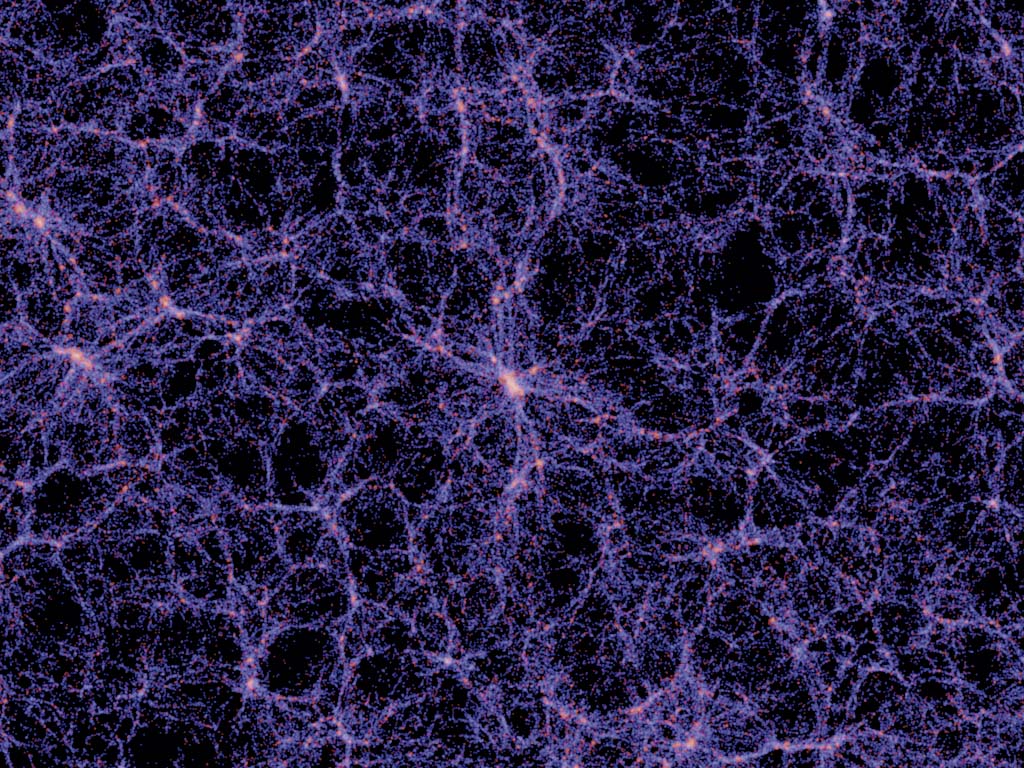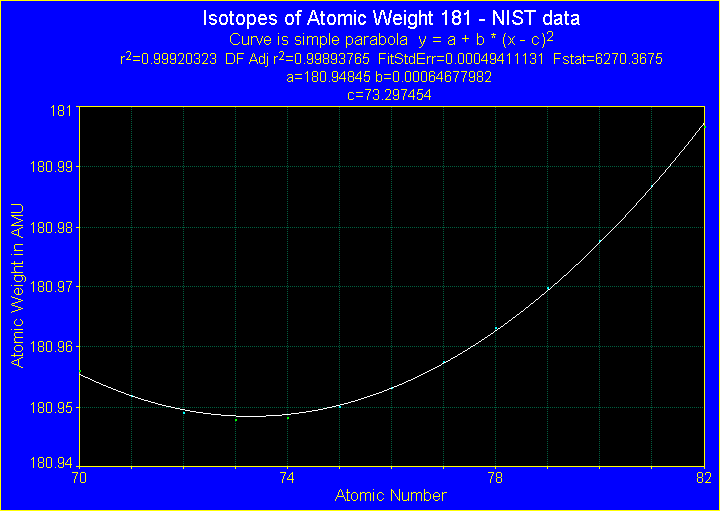Statistical Analysis of Isotope Masses: Electric forces may bind nucleus
This is a research done in the late nineties until 2003 by theoretical physicist C Johnson. Analysis of the official NIST data of nuclear energies indicates that there is a possibility atomic nuclei may be held together by electric forces rather than the special nuclear forces that are postulated in the standard model. This data, if confirmed by other researchers, could lead to a re-thinking and simplification of particle physics. The troublesome weak and strong nuclear binding forces of current theory may well turn out to be superfluous.

We are hearing much about the electric nature of the Universe these days. Galaxy clusters seem to be lined up in strings and networks, rather than randomly distributed as a merely gravity-based universe would indicate. There is also evidence of huge electric currents in space many of which connect stellar and galactic objects.
For more on the electric forces at work in the universe, you can check out the Thunderbolts Project youtube channel or, if you prefer a site, it is thunderbolts.info There are groups on Facebook: Electric Universe Theory and Electric Cosmology
Now THIS research potentially extends the electric concept of the universe to the level of particles. If confirmed, this would seem to simplify many things in particle physics.
http://mb-soft.com/public2/nuclei6.html
Nuclear Physics - Statistical Analysis of Isotope Masses

Neutrons certainly exist in open space, but they may not actually exist inside atomic nuclei.
For one obvious thing, the energy required to bind a neutron together does not seem to exist in the NIST precise data. Instead, there appears to be very strong statistical evidence that separate protons and electrons exist within atomic nuclei, which actually seems to greatly simplify many subjects in atomic and nuclear physics.
The protons appear to be in specific geometric structures, generally being very rapidly revolving Regular Polyhedrons.
Since both the protons inside the nuclei and all the electrons revolve around the center of the nucleus at a good fraction of the speed of light, to our perception, the many Regular Polyhedrons revolve at many billions of times every second, and our "Slow Eyes" see both the proton patterns within the nucleus and the electron configurations where we tend to consider them to be "Shells" (at constant radius and energy).
THIS Research suggests that the protons inside the atomic nucleus are also in stable patterns like Regular Polyhedrons, which also rotate many billions of times every second, also giving the suggestion of being in Shells (which then seem to be spheres) inside the nucleus. Meanwhile, the electrons which are inside the nucleus 'Migrate' at relativistic velocities.
There is much analysis and elaboration of statistical data in this research. Best to see it on the original page which is





Jan Olof Jonson comments by email:
Thank You for informing me abot this research! It saves me much bothering, since the work has already been done by another scientist.
I have - as You may remember - been working mostly on proving that there is no specific magnetic force, nor is there any wave-particle duality of light, thus side-stepping whole the Maxwell concept.
Please see my updated list of publications!
Sincerely Yours,
Jan Olof Jonson
Publication list
PR denotes Peer Review judged papers
1997 PR The Magnetic Force Between Two Currents Explained Using Only Coulomb's Law Chinese Journal of Physics, Volume 35, No. 2, pp. 139-149. http://psroc.phys.ntu.edu.tw/cjp/issues.php
2002 What is Gravity? Journal of Theoretics, Volume 4, No. 1 http://www.worldsci.org/pdf/abstracts/abstracts_4728.htm
2003 Refutation of Feynman's Derivation of the Lienard-Wiechert Potentials Journal of New Energy, Volume 7, No. 3, pp. 42-44 2003, 10th Natural Philosophy Alliance Conference, Storrs, CT, United States, http://www.worldsci.org/php/index.php?tab0=Abstracts&tab1=Display&id=1681&tab=2. ISBN 1086-8259
2003 The Law of Electromagnetic Induction Proved to be False Using Classical Electrostatics Journal of Theoretics, Volume 5, No. 3, (8 pages) http://www.journaloftheoretics.com/Articles/aArchive.htm
2004 PR Towards a Classical Explanation to the Stable Electron Paths around Nuclei and to Radiation in Connection with the De-Excitation of Excited Electrons 2004, International Congress 2004: Fundamental Problems of Natural Sciences and Engineering, St. Petersburg, Russia
2007 PR Photon as a Classical Wave Packet from Classically Stabilized Electron Orbits The Nature of Light , Volume 6664, pp. 33 DOI: 10.1117/12.747574
2007 Towards a Classical Explanation for the Stable Electron Paths Around Nuclei and to Radiation in Connection with the De-Excitation of Excited Electrons Proceedings of the NPA, Volume 4, No. 1, pp. 92-96 2007, 14th Natural Philosophy Alliance Conference, Storrs, CT, United States http://www.worldsci.org/php/index.php?tab0=Abstracts&tab1=Display&id=905&tab=2
2008 Implications of Infinite Current Densities at Idealized DC Generator Poles Proceedings of the NPA, Volume 5, No. 1, pp. 119-120 2008, 15th Natural Philosophy Alliance Conference, Albuquerque, NM, United States http://www.worldsci.org/php/index.php?tab0=Abstracts&tab1=Display&id=30&tab=2
2008 Turning Back to Coulomb's Law as a Basis for Electromagnetism Proceedings of the NPA, Volume 5, No. 1, pp. 113-118 http://www.worldsci.org/php/index.php?tab0=Abstracts&tab1=Display&id=29&tab=2
2009 The Sagnac Effect Explained Using the Special Relativity Theory 2009, 16th Natural Philosophy Alliance Conference, Storrs, CT, United States http://www.worldsci.org/php/index.php?tab0=Abstracts&tab1=Display&id=1214&tab=2
2009 The Magnetic Force Between Two Currents Further Analyzed Using Coulomb's Law And Special Relativity Theory 2009, 16th Natural Philosophy Alliance Conference, Storrs, CT, United States http://www.worldsci.org/php/index.php?tab0=Abstracts&tab1=Display&id=1077&tab=2
2010 A Comparison between Ampere's Law, Coulomb's Law and the Lorentz Force Proceedings of the NPA, Volume 7, No. 8, pp. 232-239 17th Natural Philosophy Alliance Conference, Long Beach, CA, United States http://www.worldsci.org/php/index.php?tab0=Abstracts&tab1=Display&id=5425&tab=2
2010 More on the Magnetic Force Between Two Currents Proceedings of the NPA, Volume 7, No. 2, pp. 679-689 2010, 17th Natural Philosophy Alliance Conference, Long Beach, CA http://www.worldsci.org/php/index.php?tab0=Abstracts&tab1=Display&id=6394&tab=2
2011 Coulomb's Law is the Basis for Radiation Energy Proceedings of the NPA, Volume 8, pp. 303-305 2011, 18th Natural Philosophy Alliance Conference, College Park, MD, United States http://www.worldsci.org/php/index.php?tab0=Abstracts&tab1=Display&id=6074&tab=2
2011 The Attractive Force between Two Parallel Currents Explained by Coulomb's Law Proceedings of the NPA, Volume 8, pp. 299-303 2011, 18th Natural Philosophy Alliance Conference, College Park, MD, United States http://www.worldsci.org/php/index.php?tab0=Abstracts&tab1=Display&id=6127&tab=2
2013 PR Ampère's Law Proved Not to Be Compatible with Grassmann's Force Law Engineering » Electrical and Electronic Engineering » "Electromagnetic Radiation", book edited by Saad Osman Bashir, ISBN 978-953-51-0639-5, DOI: 10.5772/37978
2013 PR The Use of Finite Differences on Electric Currents Gives Credit to Coulomb‟s Law as Causing Electromagnetic Forces, thereby Explaining Electromagnetic Induction DOI: 10.7763/IJMO.2013.V3.301 (IJMO)
2014 PR The Claim that Neumann’s Induction Law Is Consistent with Ampère’s Law Rejected DOI: 10.7763/IJMO.2014.V4.394 (IJMO)
2014 PR The Use of Coulomb’s Law can Account for the Attractive Force between Electromagnets Journal of Basic and Applied Physics, Vol. 3 No. 4, 2014 http://www.academicpub.org/jbap/paperInfo.aspx?PaperID=15353
2015 PR The Repulsive Force Within Ampère’s Bridge Explained by Coulomb’s Law and Special Relativity Theory, Taking into Account the Effects of Propagation Delay, Journal of Basic and Applied Physics, Vol. 4 No. 3, PP. 29-39, DOI: 10.5963/JBAP0403002, http://www.academicpub.org/jbap/paperInfo.aspx?PaperID=16667
2015 PR The Electromagnetic Force between Two Parallel Current Conductors Explained Using Coulomb’s Law, Electrical and Electronic Engineering » "Advanced Electromagnetic Waves", book edited by Saad Osman Bashir, ISBN ISBN 978-953-51-2205-0, DOI code not yet activated http://www.intechopen.com/articles/show/title/the-electromagnetic-force-between-two-parallel-current-conductors-explained-using-coulomb-s-law
Paul Werbos, also by email, comments
Thank you, Sepp!
I would argue that the results you cite are just exactly half right, if that is possible.
The B and W meson forces of the electroweak theory (EWT) have been very thoroughly validated empirically in other contexts. Likewise the existence of a HIggs force, even if the exact form is not quite yet the standard one. Yet at the same time, the results you discuss are compatible with those of Macgregor, in Power of Alpha.
Julian Schwinger himself proposed years ago that nucleon properties can be predicted by a different kind of model from QCD -- but the politics of QCD have become amazingly medieval. When I understood about Schwinger's suggestion, I did a literature review, to find out whether it had been disproven. I was astounded to learn that all the empirical evidence, while circumstantial, favored Schwinger over QCD and, even more amazing and much more disturbing, that the world has steadfastly refused to do the relatively inexpensive experiments which would settle this one way or another. My review (and pointer to experimental needs) is in the "flying saucer" section of arxiv.org (Ginsparg being a true loyalist for QCD).
Schwinger actually did have some experimental collaborations late in life, showing that the empirical implications of his viewpoint are substantial, more testable than I realized at first, and dangerous. In his model, there is not an absolute conservation of baryon number,
and coherence effects do appear to make it possible to perturb that. So maybe there could be a method in Ginsparg's madness. But even so, in the world as it is now, perhaps the truth does need to get out anyway.
It is possible to reconcile "power of alpha" kinds of numerical relations with modified electroweak theory and Schwinger's picture, if one looks closely enough at the relevant mathematics.
Another comment, this one by Johan Marinsek from Austria (sent by email)
Dear Sepp! Servus!
Many questions of Johnson are treated in my:
http://www.foundationsofphysics.org
The Bohr atomic model with nuclei and electron shells is untenable.
Compact atoms comprise hydrogen atoms, their number is identical with the mass number A. (William Prout 1819) The surface of the atom is responsible for its bonding behavior. Think Lego toys. All bonding is due to electromagnetic forces…
There are no neutrons as parts or the stable atom. Hydrogen consists of a proton and an electron. Observed “neutrons” of decaying atoms are hydrogens that decay further.
Moseley’s law is a failure: There is no evidence that the atomic number of the atom is identical with the number of extra nuclear electrons and the number protons in the nucleus.
Masses of all elements and their isotopes are known:= the mass numbers A [Da].
Johnson uses mass spectrometry values that are all pointless.
Proof: When carbon C has mass 12,00 then helium He-4 has exactly mass 4.00. This teaches chemistry (Dalton, Prout, Proust) and even the wrong atomic model where the ratio of C and He masses is exactly 12:4.
But mass spectrometry based tables specify for the mass of C and He: 12.00 and 4.0026! The source of the error is described in my papers. When the correct masses are applied, no mass defect occurs and Einstein’s formula for the binding energy of the elements is not applicable!
Johnson’s misunderstanding regarding mass values:
For 75Re181 it is currently known (NIST data) as 180.950065 AMU. For 76Os181 it is 180.95327
The two Isobars(!) have a mass value of 181 [Da]! Different NIST –values are due to erroneous mass calculations! A Times of Flight Mass Spectrometer measures for Re-181 a shorter time of flight than for Os-181. Therefore the calculated mass for Re is smaller than for Os-181-
Explanation: Classical mechanics (in a vacuum) yields faulty results for mass calculation. It is necessary to take into account a drag effect of the dielectric medium (aether). Drag coefficient of Re-181 is smaller than for Os-181 due to a different structure of the atom…
See my articles.
More on bonding etc.
Best regards, Johann Marinsek, Austria
Glen Collins says there were others before who said essentially the same thing:
Hi Sepp,
Thanks for the posting. Dr. Bill Lucas and David Bergman, following the work of the late Dr. Thomas Barnes, have been saying for over 20 years, and demonstrating via calculation, that electrical and magnetic forces, only, hold together everything. This is not new by any stretch.
Best regards,
Glen Collins
By Tomasz Maciejewski:
Hello Mr Sepp Hasslberger,
Thanx's for publishing site with such interesting aspects. Just to notice, the same aspect and some other were proposed and dicsussed by Michal Gryzinski, polish physicist, which was working since 1959. The book he wrote was "The Case of Atom" with many aspects like superfluous weak and strong forces, quantization of electron orbitals by precession of the rotation axis of the electron (effecting in the structure of atoms), free-fall electron trajectory, proposed internal structure of neutron (proton & electron), weaknesses of Michelson-Morley experiment (ether existence), weaknesses of quantum mechanics, other. Very strong explanation in equations.
https://en.wikipedia.org/wiki/Free-fall_atomic_model
regards,
T.Maciejewski
A reaction from Si Wells - also by email...
Thank you for the article. This "C Johnson" seems to be an interesting fellow-- whom it would be nice to know a little more about, from an independent source.
Although I have little expertise in the the field of Nuclear Physics, I do find the article on isotope analysis intriguing. I have long held suspicions about the so-called "strong", or nucleon binding, force. There are in fact some 'strong' reasons for rejecting it as a force distinct from the electromagnetic and gravitational forces. The "weak" nuclear force has already been discovered to be a form of EM force: I agree with C Johnson that the strong force may have to follow. As I do not possess the technical knowledge of isotope analysis to critique Johnson's reasoning or to include those findings in my own study, I shall merely present my own concerns and conjectures in a simple open letter to the science community. This will be more expedient than attempting to prepare a formal paper on the subject.
Like Johnson, my initial concern came about over the extremely short-range nature of the strong force. This is entirely uncharacteristic of the other fundamental forces; rather, it would seem more in the nature of an induced phenomenon, like tidal forces between neighboring elastic masses, or electrostatic force augmentation between closely approaching oppositely charged conductors. This theme I have developed into a tentative working hypothesis for nuclear energy. to be elaborated shortly. First, though, let the various lacunae and inconsistencies in currently established theory be exhibited:
1. The strong force, though short-range, is exceedingly powerful compared to the electromagnetic force. On this account, at close quarters the strong force should overcome the electrostatic force to bind charged nucleons firmly together (e.g., protons) Therefore, nuclei of low atomic number should not require neutrons to participate in the binding process, and stable isotopes such as Helium-2, Lithium-3, Beryllium-4 etc. should be encountered regularly in nuclear physics experiments and applications. No such isotopes have ever been discovered. (Indeed, aggregates of 'super protons' should also exist, consisting of at least several bound protons.)
2. Aggregates of pure neutron masses, consisting of dozens, if not hundreds, thousands, and millions of neutrons should exist, and should have been discovered, but no such aggregates have been reported.
3. The existence of neutrons in the heavier elements should have little effect on the overall binding integrity of their nuclei; in fact, increasing neutron numbers could act to destabilize nuclei, since individual protons, alpha particles, and larger fractions of the nucleus, now separated by greater distance, would lose the close-quarter strong-force binding enhancement with each other, and yield to electrostatic repulsion more readily.
4. In that other forces operate through the agency of a physical "field", a "nuclear field" should be detectable as an inverse square function of distance from nucleon field source. No such field has been detected.
5. A separate species of "nuclear radiation" should exist, composed not of electromagnetic or gravitational field flux, but of nuclear field flux, and should be a powerful agent in causing other nuclear reactions. No such radiation has been detected. Instead, all energy released from nuclear reactions has been found to be in the form of kinetic particle emissions or in that of electromagnetic radiation.
Other inconsistencies and inadequacies of standard nuclear theory, such as those entertained by C Johnson, may be discovered in addition to the above.
Like C Johnson's investigations, the foregoing observations point to a purely electromagnetic cause for nuclear binding. Let the neutron matter be supposed to be composed of equal amounts of negatively and positively charged material, normally in distributive equilibrium. The intensity of the close-quarter force may be attributed to an extreme quantum-level induced concentration of electric flux between neighboring proton matter and neutron matter: each interface of these material constituents is characterized by a narrow channeling of flux lines between the positive charge on proton matter which are adjacent to topical concentrations of negative charge, raised as extreme 'charge tides', on the neutron matter. The residual positive flux from the neutron matter, separated from the negative, is directed radially away in sundry other directions. The effect is analogous to the notorious "quantum tunneling" which enables fusion of protons with otherwise insufficient kinetic energy: A sudden, and marked, directional quantizing of the flux concentration between proton and neutron enables extreme augmentation of electrical binding. This topical flux concentration model thus explains the necessity of neutrons in the binding process, while obviating the need for exotic and oddly-acting nuclear "strong forces", independent of electromagnetic and gravitational force actions. This model also accounts for both nuclear fission and nuclear fusion: 'Tidal forces' are characteristically of a greater inverse power dependence than ordinary inverse square forces, and have a tendency toward inverse exponential relation to distance. This is due to extreme deformation of interacting bodies due to the tidal forces themselves. For small nuclei at very close range, the enhanced proximity of interacting agents overwhelms the structural integrity of the bodies, as the 'charge tides' virtually merge into a nearly dissoluable bond. Fusion energy is released in the formation of this bond. Fission becomes possible when the tidal forces of large nuclei are unable to reach effectively across greater nuclear diameters, and the electrostatic proton repulsion begins to dominate, especially when collision with other particles acts to dislocate further the weakened nuclear configuration. Again, energy is released.
This hypothesis is submitted for peer review by NPA members and their associates.